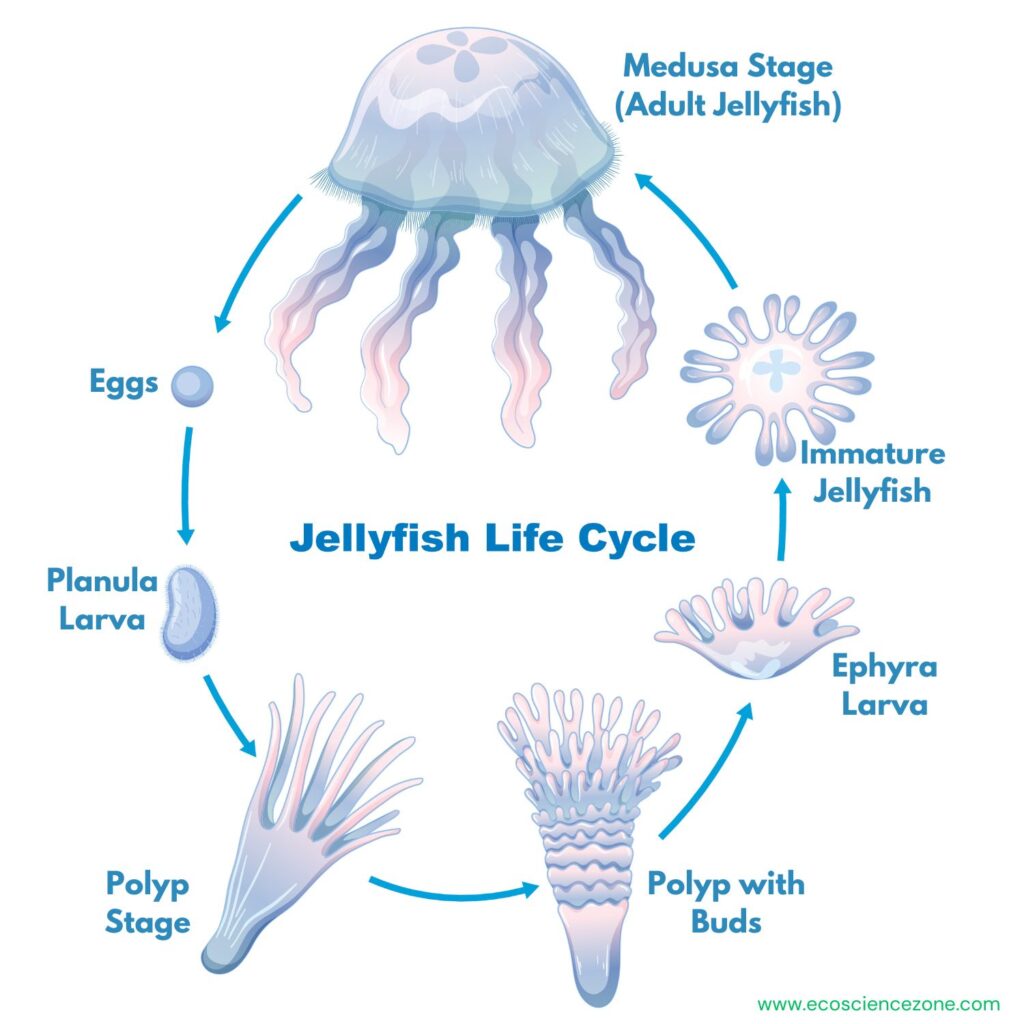Jellyfish are some of the most mesmerizing creatures when observed in aquariums, but they can be dangerous when encountered in the open ocean. From curious students to seasoned scientists, these gelatinous drifters captivate many, sparking endless fascination. As we dive into learning about them, countless questions arise.
In this article, we’ll explore and answer some of the most commonly asked questions about these mysterious marine beings.
What Do Jellyfish Eat? (In Captivity and the Wild)
One of the most common questions about jellyfish is : What do they eat, whether in an aquarium or in the open ocean?
In captivity, slimy creatures primarily eat small fish, fish larvae, and Artemia – commonly known as baby brine shrimp. Artemia is a preferred food source because it remains suspended in the water, allowing jellies to consume it easily. In aquariums, it is often provided in frozen form, as it is readily available and fish and crustaceans enjoy it as well.
In the wild, these ocean drifters have a more varied diet. They prey on small crustaceans, plankton, fish larvae, and even other jellyfish. Many species rely heavily on free-floating plankton, which is abundant in ocean waters, ensuring their survival and growth.
Important Considerations
1. Jellyfish Overgrowth and Marine Ecosystem Disruption
A sudden increase in jellyfish populations can be harmful to marine ecosystems. By consuming large amounts of fish larvae, they can reduce fish populations, leading to long-term ecological imbalances.
2. Impact of Overfishing
Due to overfishing of species such as sardines and anchovies, which naturally compete with jellyfish for food, creates an imbalance in the ecosystem. Thus jellyfish face less competition and are able to thrive unchecked, leading to a rapid surge in their population. Consequently, this unchecked growth can disrupt marine food chains and further alter oceanic ecosystems.
By understanding their diet and ecological role, we can better assess the impact of these jellies on marine biodiversity.
Not only humans have empathy and parental care, there is a fish which has great connection with its offsprings. Please do read the story of “The Grieving Orca” –
What Eats Jellyfish? Who Feeds on These Ocean Drifters?
Nature maintains balance in the ecosystem by controlling the populations of every species, including sea jellies. Many large predators depend on jellies as a source of food, helping to control their numbers. Leatherback turtles, tuna, and swordfish are among the primary jellyfish predators, while some seabirds, such as fulmars and albatrosses, also eat them.
In addition, whale sharks, humpback whales, and some crab species such as hermit and arrow crabs include these jellies in their diets. One of the most fascinating predators is the sea anemone, a deep-sea creature attached to the sea floor that catches jellyfish drifting on the sea floor.
Jellyfish in Human Consumption and Traditional Medicine
These slimy creatures are also used in traditional Chinese medicine, believed to aid in treating arthritis and high blood pressure. For centuries, they have been part of the cuisines of many East and Southeast Asian cultures, including China, Japan, Korea, and Vietnam.
Major Ecological Concerns
1. Role of Overfishing
Large-scale fishing operations often remove key jellyfish predators, such as leatherback turtles, which can lead to uncontrolled growth in jellyfish populations.
Overfishing is a new age threat read more about it – https://www.edf.org/sustainable-fishing/overfishing-most-serious-threat-our-oceans
2. Human impact on jellyfish predators
Popular seafood species such as tuna and swordfish are overfished. With fewer natural predators in the ocean, jellyfish populations can increase dramatically, disrupting marine ecosystems.
By understanding the natural predators of jellyfish and the impact of human activities, we can better understand the delicate balance of marine ecosystems and the consequences of its disruption.
How do jellyfish reproduce?
Jellyfish, despite being simple invertebrates without developed organs, a central nervous system or a brain, have a surprisingly diverse reproductive cycle. These fascinating creatures can reproduce both sexually and asexually, allowing them to thrive in changing environmental conditions – earning them the name “floating phantoms.”
The Two-Stage Life Cycle of Jellyfish
These gelatinous creatures go through two distinct life stages: polyp and medusa.
1. Polyp Stage (Asexual Reproduction)
In this stage, jellyfish exist in the ocean as tube-like structures attached to surfaces such as rocks or man-made structures. Polyps reproduce asexually by budding, releasing many smaller polyps that form colonies.
2. Medusa Stage (Sexual Reproduction)
As jellyfish mature into their adult, free-floating umbrella shaped medusa forms and they reproduce sexually. Adult jellyfish release sperm and eggs into the water, where fertilization occurs. The fertilized egg develops into a freely floating larva called a planula, which eventually settles to the surface, transforms into a polyp, and continues a lifelong reproductive cycle.

Key Ecological Considerations
1. Man-made structures encourage jellyfish growth
Because of their unique reproductive cycle, man-made structures such as offshore platforms, docks, and artificial reefs make ideal breeding sites, leading to an increase in jellyfish populations.
Human encroachment in oceans have negative impact on marine ecosystem, read more – https://www.sciencelearn.org.nz/resources/144-human-impacts-on-marine-environments
2. Jellyfish are highly resilient to environmental changes
Unlike many marine species, jellyfish populations are unaffected by extreme ocean conditions, such as rising temperatures or increased ocean acidity. Their ability to reproduce in multiple ways ensures their survival even as the ecosystem changes.
In this changing environmental conditions many species are struggling for their survival. Want to know more about such species –
By understanding the life cycle of these jellies, we gain insight into their rapid population growth and resilience – factors that make them both fascinating and a growing concern in marine ecosystems.
Are Jellyfish Immortal?
All living organisms follow a natural cycle of birth and death, and these floating phantoms are no exception. However, one species, Turritopsis dohrnii, is often referred to as the “immortal jellyfish,” because it has the extraordinary ability to regenerate and avoid death like no other known creature.
The Secret of Immortality: A Unique Life Cycle
Like other jellyfish, Turritopsis dohrnii follows a two-stage life cycle:
1. Polyp Stage – This stage consists of small, highly branched polyps that attach to surfaces and develop into young jellyfish (medusae).
2. Medusa Stage – Once fully grown, the jellyfish matures, reproduces sexually, and completes a normal life cycle.
The Astonishing Twist
Unlike other jellies, when Turritopsis dohrnii reaches old age, suffers an injury, or encounters harsh conditions, it undergoes a remarkable transformation. Instead of dying, it reverts back to its polyp stage, settles on the ocean floor and begins its life cycle again. This process is called transdifferentiation, which allows it to potentially live forever under the right conditions.
Though not truly “immortal” in the sense of invincibility, this unique ability to cheat death and begin anew makes Turritopsis dohrnii one of the most fascinating organisms in the natural world.
Why is Jellyfish Dangerous? Does It Sting? Is it Poisonous Or Venomous?
When people think of jellyfish, they often picture painful stings, burning sensations, and, in severe cases, breathing difficulties. Those who have encountered these sea drifters remember one thing—the lasting scars they leave behind. But what makes them so dangerous?
The Sting: How Jellyfish Deliver Their Venom
These marine stingers possess long, ribbon-like tentacles lined with microscopic stinging cells called nematocysts. When an individual comes into contact with these tentacles, the nematocysts pierce the skin and inject venom, triggering a reaction that ranges from mild irritation to intense pain and hypersensitivity.
The severity of the sting depends on the species of jellyfish, as the chemical composition of their venom varies. Some stings cause temporary discomfort, while others can lead to severe allergic reactions and even life-threatening conditions.
The Hidden Danger: Even Dead Jellyfish Can Sting
One of the most alarming facts about these sea jellies is that their nematocysts remain active even after they die. This means that beached jellyfish can still sting unsuspecting beachgoers, making it essential to be cautious even when they appear lifeless along the shore.
Who Is Most at Risk?
1. Local Fishermen – Fishermen often get stung while untangling these slimy bodies caught in their nets. Their daily exposure to jellyfish-infested waters puts them at constant risk.
2. Tourists and Swimmers – In regions experiencing jellyfish blooms, sudden surges in these stinging swarms can force beach closures, disrupting tourism and posing health hazards.
With jellyfish populations on the rise due to climate change and overfishing so encounters with these stinging drifters are becoming more frequent. It is essential to stay informed and take precautions when venturing into jellyfish-prone waters.

Wrapping It Up for these “Sea Monsters”
Jellyfish, because of their delicate and translucent forms, are undeniably among the greatest survivors of the natural world. For millions of years, they have thrived by adapting seamlessly to ever-changing environments, all while maintaining their unique identity in modern ecosystems. Furthermore, their remarkable diversity and resilience enable them to flourish in both the vast depths of the ocean and along coastal regions. As a result, they continue to captivate scientists and marine enthusiasts alike, serving as a fascinating subject of ongoing research and discovery.
From having 95% of their bodies made of water to forming massive blooms that can disrupt entire ecosystems, jellies are full of paradoxes. They may have short lifespans, yet their populations can expand rapidly, influencing marine food chains and human activities.
We hope you enjoyed exploring these intriguing insights into these sea jellies. If you found this article interesting, stay tuned—there’s much more to uncover about these mysterious sea drifters!
To understand more about us – READ MORE –

Leave a Reply